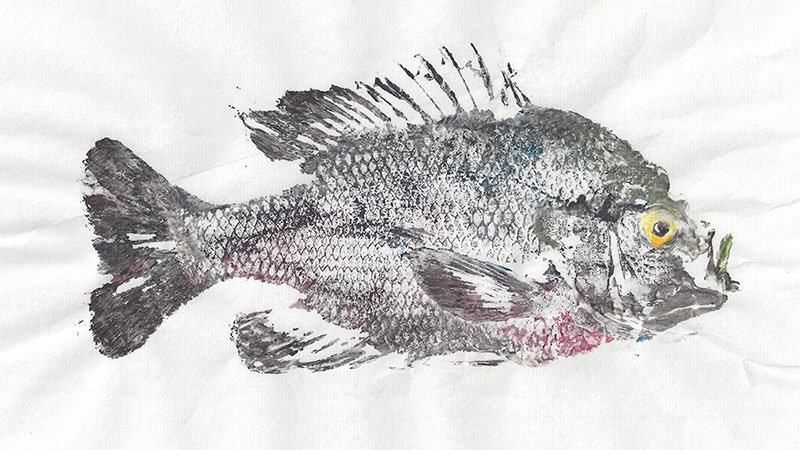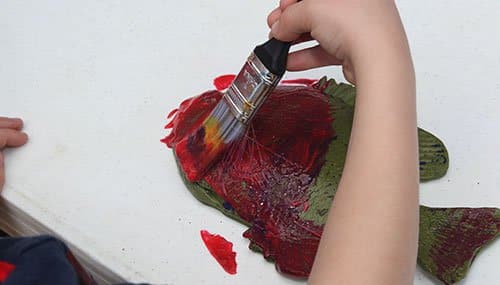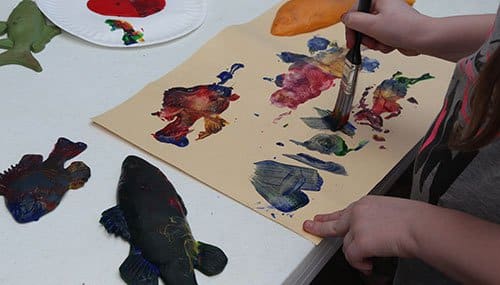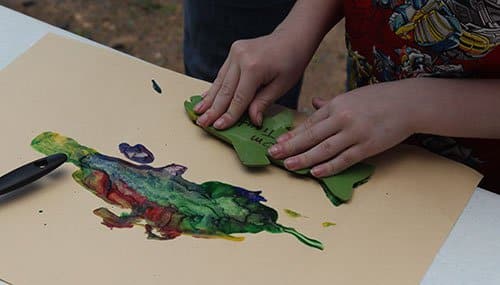Have Your Catch and Eat it, too
ON 05-20-2020

May 20, 2020
Randy Zellers
Assistant Chief of Communications

LITTLE ROCK — Trophy or table-fare? Catch a notable fish and you’re stuck with the choice. Besides the high cost, taxidermy requires handing over your prize instead of enjoying it as a meal. A quick photo of the fish at the time of the catch is nice to share with friends via social media, but rarely are worthy of hanging on a wall.
Anglers from overseas faced the food-or-fame dilemma centuries ago, and their solution was so popular, it became folk art. Japanese fishermen would bring paper and ink along on their trips to make impressions of fish they caught. They would paint one side of the fish with ink, and press it to paper. The ink would transfer to the paper, showcasing the fish’s size. Once satisfied with their record, they would wash the fish and still be able to bring it back for a meal or market.
A Little History
No one really knows the name of the first angler to capture his catch in artwork, but the oldest existing fish print is of a large red sea bream, caught by Lord Sakai of the Yamagata prefecture in 1862. Soon after his artwork was displayed, the practice became a recognized art form called gyotaku (gyo – meaning “fish” and taku – meaning “stone rubbing”).
Many modern artists have added their own touch to the process, transforming basic shapes into multicolor masterpieces, some of which sell for hundreds of dollars. But you don’t have to be an artist to enjoy the hobby, and there’s no better way to add even more excitement to a child’s first catch.
’Taku Tools

Gyotaku requires only a few items found in practically any art supply store – paper, paint and brush.
While any paper will make a decent “fish print,” the best option usually is rice paper; another good choice is parchment paper used for baking. Crumple the paper into a ball and smooth it back out a few times to offer a crackled texture and make it more flexible.
Use non-toxic paint, especially if you plan on eating the catch. Non-toxic acrylic paint is thin enough to show fine details and comes in a variety of colors. Dark paints help make small details stand out, but some people like to match the color of the fish in their print.
There’s no need to splurge on an expensive paintbrush; the fish is doing the real painting. An inexpensive sponge brush works well to coat the fish with the pigment. A fine-tipped paintbrush also comes in handy to touch up the work and add detail to the fish’s eye.
Find a Fish
The best part of making a fish print is finding the fish. Arkansans are blessed with so many streams, lakes and rivers that finding a fishing location is as easy as a quick search on agfc.com. When it comes to finding a youth’s first fish, the Family and Community Fishing Program offers ponds in major cities around the state to get young anglers hooked. Visit www.agfc.com/familyfishing to discover one of these locations near you.
Crappie, bass, bream and other fish with large scales tend to make the best prints; catfish can be printed, but it requires a delicate hand.
Fishy Flair

Clean the fish with water and a bit of dishwashing detergent to remove its protective slime coat. This slimy layer offers an excellent barrier to bacteria and fungus, but can cause the paint to smear into a featureless blob. Press paper towels against the fish to dry it. Be sure to wipe the insides of the gills and undersides of the fins as well; any water left in these areas will be squeezed onto the paper when pressed. Give the fish a firm squeeze at the belly to ensure all liquids are purged.
Lay the fish on a flat surface and use newspaper or magazines to prop up the dorsal and anal fins.
Use the sponge brush to apply a light coat of paint to one side of the fish; coat everything but the eye. Be sure to apply paint to the mouth and fins.
Place the paper over the fish and press firmly across the entire painted surface. Do not let the paper move once it is placed over the fish. Pull the paper straight up off the fish’s body look over your artwork.
Don’t be discouraged if the first print doesn’t have much detail. This usually means there’s too much paint on the fish. Just press more clean sheets against the fish until you get the look you like. If you run out of pigment, you can repaint and try again.
Paint in the fish’s eye using the fine-tipped paintbrush. You can also add a few details to add color or contrast. Trout wouldn’t look the same without their spots, and crappie come to life when you darken a few random scales and add a few specks to their fins.
Once you’re satisfied with your print, wash the fish, filet it and cook up your catch knowing you’ll always have a record of the one that didn’t get away.
Recent News
Subscribe to Our Weekly Newsletter E-mails
Don’t miss another issue. Sign up now to receive the AGFC Wildlife Weekly Newsletter in your mailbox every Wednesday afternoon (Waterfowl Reports are published weekly during waterfowl season and periodically outside the season). Fishing Reports arrive on Thursdays. Fill in the following fields and hit submit. Thanks, and welcome!


